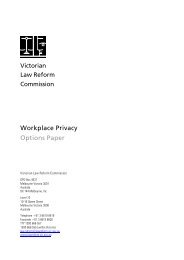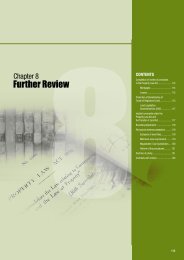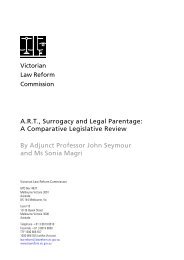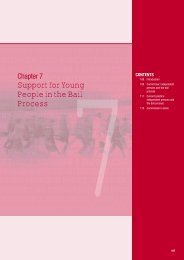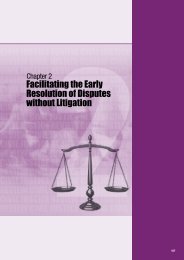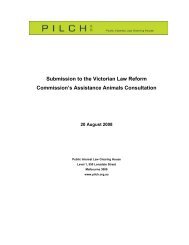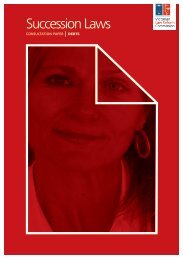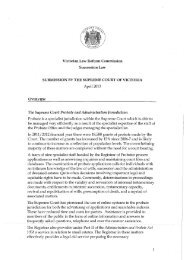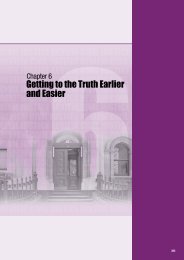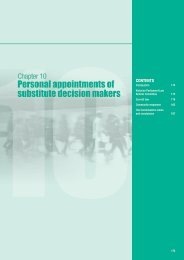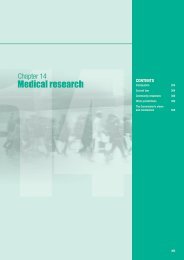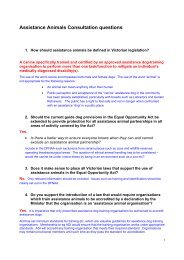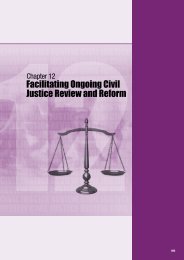Crimes Mental Impairment consultation paper.pdf - Victorian Law ...
Crimes Mental Impairment consultation paper.pdf - Victorian Law ...
Crimes Mental Impairment consultation paper.pdf - Victorian Law ...
You also want an ePaper? Increase the reach of your titles
YUMPU automatically turns print PDFs into web optimized ePapers that Google loves.
2<br />
2.16 Prior to these reviews, the <strong>Law</strong> Reform Commission of Victoria also conducted work in<br />
this area and made a number of recommendations regarding the insanity defence in<br />
its report on <strong>Mental</strong> Malfunction and Criminal Responsibility. 7 An extensive review of<br />
sentencing in Victoria undertaken by the <strong>Victorian</strong> Sentencing Committee in 1998 also<br />
examined and made recommendations on the Governor’s pleasure regime. 8<br />
2.17 These reviews, along with much academic commentary, highlighted a number of<br />
problems with the Governor’s pleasure regime:<br />
• Lack of coherent framework—the detention, management and release of people<br />
found to be either unfit to plead or not guilty on the ground of insanity under<br />
the Governor’s pleasure regime was regulated by various pieces of legislation and<br />
convention. There was no single piece of legislation that set out the process that<br />
applied to people under Governor’s pleasure orders. 9<br />
• Overlap with the criminal justice system of detention, supervision and review—there<br />
was the possibility of people being detained in the prison system even though they<br />
were not criminally responsible for their crime. 10 The involvement of the Adult Parole<br />
Board, that generally makes decisions in relation to people found guilty of an offence,<br />
in making recommendations for the release of people under Governor’s pleasure<br />
orders, also brought these people under the criminal justice system. 11<br />
• No testing of evidence—people found unfit to plead to criminal offences would be<br />
detained at the Governor’s pleasure without a further hearing to test the prosecution<br />
evidence against them and to determine whether or not they committed the criminal<br />
offences charged. 12<br />
• Involvement of the executive—the executive 13 made decisions on the release of<br />
people under Governor’s pleasure orders. A decision to release a person under a<br />
Governor’s pleasure order could be influenced by political considerations that could<br />
favour community safety over the rights of the person subject to the order. 14<br />
• Duration of detention—the process that was in place, particularly the involvement of<br />
the executive in decisions to revoke Governor’s pleasure orders, resulted in periods<br />
of detention that were ‘far in excess of the time required for effective treatment’. 15 A<br />
study by the Commission of all people subject to Governor’s pleasure orders between<br />
1959 and 1988 provided some indication that orders were based on a tariff system<br />
rather than a genuine assessment of dangerousness. 16<br />
• Lack of transparency and procedural fairness—the Governor’s pleasure regime lacked<br />
transparency, particularly in relation to the process behind the executive’s decision to<br />
release a person subject to a Governor’s pleasure order. Leave decisions were also not<br />
transparent, for example, the criteria for granting leave were not clear and had no<br />
legislative basis. The right to appear and to appeal leave decisions was limited.<br />
7 <strong>Law</strong> Reform Commission of Victoria, <strong>Mental</strong> Malfunction and Criminal Responsibility, Report No 34 (1990).<br />
8 <strong>Victorian</strong> Sentencing Committee, Sentencing – Report of the <strong>Victorian</strong> Sentencing Committee, Volume 2 (1988) 387–482.<br />
9 Community Development Committee, Parliament of Victoria, Inquiry into Persons Detained at the Governor’s Pleasure (1995) 29.<br />
10 Ibid 48.<br />
11 Ibid 94–5.<br />
12 Ibid 119.<br />
13 The executive is the administrative arm of government and comprises government employees who work in government departments and<br />
agencies. Ministers, who are members of the legislature, also work as part of the executive.<br />
14 Community Development Committee, above n 9, 2.<br />
15 Ibid 1.<br />
16 <strong>Law</strong> Reform Commission of Victoria, above n 7, 6.<br />
13



